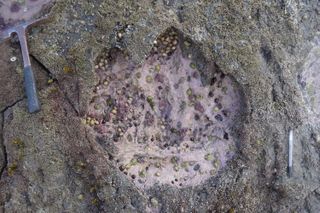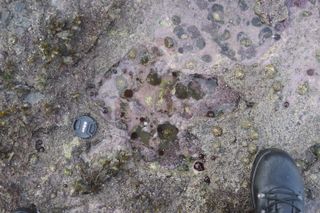Giant, Clawed Dinosaurs Left These Footprints in Ancient Lagoon
At least two types of dinosaurs left the foot- and handprints. Large, roundish tracks with toe and claw marks found at the site likely belonged to long-necked, four-legged herbivorous sauropod dinosaurs, while the smaller, three-toed and clawed footprints were probably left by two-legged, meat-eating theropods, whose relatives include Tyrannosaurus rex and Velociraptor, the researchers said.
These footprints are a rare find, and not just because they show that these dinosaurs may have felt right at home splashing through the shallow waters of the ancient lagoon that used to be there. The fossils are a prize find because they're from the Middle Jurassic, an epoch that has a poor fossil record worldwide, the researchers said. [See Photos of the Newly Discovered Dinosaur Footprints in Scotland]
"Fossils are just super-rare from this time interval," study co-researcher Steve Brusatte, a paleontologist at the University of Edinburgh in Scotland, told Live Science. "Some time periods preserve a lot of fossils, and others are mostly barren. It's the quirks of geology."

Fossilized footprints
Study co-researcher Davide Foffa, a doctoral student in the School of Geosciences at the University of Edinburgh, found the track site in April 2016 during an annual fieldwork trip to the Isle of Skye. Local hikers may know the spot as ꞌꞌRubha nam Brathairean,ꞌꞌ which is Gaelic for "Brothers' Point."
In all, the paleontologists found about 50 track marks, most of them left by the long-necked sauropods. These dinosaurs likely stood about 6.5 feet (2 meters) tall at the hip, measured about 49 feet (15 m) in length and weighed more than 10 tons (9 metric tons). Some of them left footprints as long as 2.3 feet (70 centimeters).
The theropods that left footprints at the site were likely about 19 feet (6 m) in length and weighed up to a ton (0.9 metric tons). The largest three-toed theropod footprints found there measure 1.7 feet (53 cm) in length. These prints were fossilized thanks to the lagoon's "low-energy environment," said study lead researcher Paige dePolo, a master's student of paleontology and geobiology at the University of Edinburgh.
The find is one of a growing number of sites that indicate plenty of sauropods were sloshing around shallow lagoons. In 2015, Brusatte and his colleagues found hundreds of dinosaur footprints in another, slightly younger ancient lagoon, known as the Duntulm track site, that is also on the Isle of Skye. Researchers have also found sauropod track marks in marine and lagoon sediments in Portugal, Australia and Mexico, dePolo told Live Science.
Sign up for the Live Science daily newsletter now
Get the world’s most fascinating discoveries delivered straight to your inbox.
Meat-eating dinosaurs seem to have been splashing around the lagoon as well, Brusatte said. [Photos: Giant Sauropods Plodded Along in Scottish Lagoon]

What dinosaurs left these?
It's unclear what species of dinosaurs left these prints. But fossilized track marks, just like fossilized animals, are given scientific names. It's likely that the sauropod prints are Breviparopus, a type of track mark seen at other sites, the researchers said.
Meanwhile, the theropod prints are likely those of Eubrontes, which have also been found at other sites. It's challenging to say what carnivorous species left Eubrontes, but perhaps it was "Megalosaurus, which is known from skeletons in the Middle Jurassic of England," Brusatte said.
The study was published online today (April 3) in the Scottish Journal of Geology.
Original article on Live Science.

Laura is the archaeology and Life's Little Mysteries editor at Live Science. She also reports on general science, including paleontology. Her work has appeared in The New York Times, Scholastic, Popular Science and Spectrum, a site on autism research. She has won multiple awards from the Society of Professional Journalists and the Washington Newspaper Publishers Association for her reporting at a weekly newspaper near Seattle. Laura holds a bachelor's degree in English literature and psychology from Washington University in St. Louis and a master's degree in science writing from NYU.

